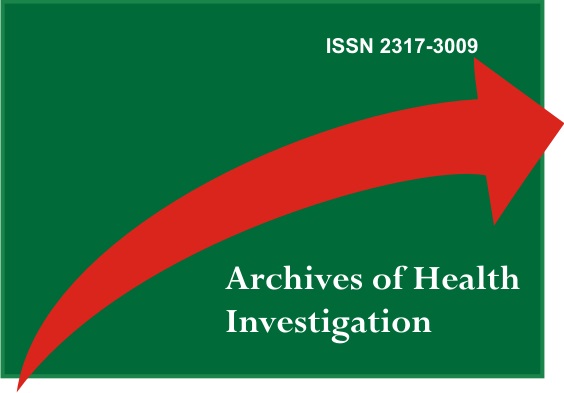A Acupuntura é efetiva no tratamento das desordens temporomandibulares? Revisão da literatura
DOI:
https://doi.org/10.21270/archi.v10i9.5258Palavras-chave:
Acupuntura, Terapia por Acupuntura, Dor Facial, Síndrome da Disfunção da Articulação TemporomandibularResumo
Introdução: A disfunção temporomandibular é um grupo de condições que apresentam como sintoma a dor na região da articulação temporomandibular. A etiologia dessa condição ainda é incerta, mas é sugerida como multifatorial. O foco principal no tratamento da disfunção temporomandibular é o controle da dor, e da disfunção do aparelho mastigatório de modo a atenuar cargas adversas que acabam perpetuando o problema. A acupuntura faz parte da Medicina Tradicional Chinesa, técnica que consiste basicamente na introdução de agulhas em pontos específicos da superfície corporal, e tem sido usada para promover o alívio da dor. Objetivo: avaliar a utilização da acupuntura no tratamento de desordens temporomandibulares. Materiais e métodos: Foi realizada uma revisão de literatura com busca nas bases dados PubMed, Lilacs, Medline e BBO no período de 2000 a 2020. Resultados: Foram encontrados 52 artigos, excluídos 37 artigos após a leitura de títulos e resumos, sendo incluídos 15 artigos. Conclusão: A partir da literatura pesquisada, pode-se concluir que a acupuntura é uma terapia de suporte complementar no tratamento das disfunções temporomandibulares e tem se mostrado tão eficiente no controle de dores faciais quanto as terapias convencionais.
Downloads
Referências
Barnes JF. Electronic acupuncture and cold laser therapy as adjuncts to pain treatment. J Craniomandibular Pract. 1984;2(2):148-52.
Bergström I, List T, Magnusson T. A follow-up study of subjective symptoms of temporomandibular disorders in patients who received acupuncture and/or interocclusal appliance therapy 18-20 years earlier. Acta Odontol Scand. 2008;66(2):88-92.
Buescher JJ. Temporomandibular joint disorders. Am Fam Physician. 2007;76(10):1477-82.
Ferreira LA, de Oliveira RG, Guimarães JP, Carvalho AC, De Paula MV. Laser acupuncture in patients with temporomandibular dysfunction: a randomized controlled trial. Lasers Med Sci. 2013;28(6):1549-58.
Gonzalez-Perez LM, Infante-Cossio P, Granados-Nuñez M, Urresti-Lopez FJ. Treatment of temporomandibular myofascial pain with deep dry needling. Med Oral Patol Oral Cir Bucal. 2012;17(5):e781-85.
Hotta PT, Hotta TH, Bataglion C, Bataglion SA, de Souza Coronatto EA, Siéssere S, et al. Emg analysis after laser acupuncture in patients with temporomandibular dysfunction (TMD). Implications for practice. Complement Ther Clin Pract. 2010;16(3):158-60.
Hunter EK. Integration of rehabilitation and acupuncture in the treatment of a professional musician with temporomandibular joint dysfunction. Acupunct Med. 2011;29(4):298-301.
Katsoulis J, Ausfeld-Hafter B, Windecker-Gétaz I, Katsoulis K, Blagojevic N, Mericske-Stern R. Laser acupuncture for myofascial pain of the masticatory muscles. A controlled pilot study. Schweiz Monatsschr Zahnmed. 2010;120(3):213-25.
Ritenbaugh C, Hammerschlag R, Dworkin SF, Aickin MG, Mist SD, Elder CR, et al. Comparative effectiveness of traditional Chinese medicine and psychosocial care in the treatment of temporomandibular disorders-associated chronic facial pain. J Pain. 2012;13(11):1075-89.
Rosted P. Introduction to acupuncture in dentistry. Br Dent J. 2000;189(3):136-40.
Rosted P, Bundgaard M, Pedersen AM. The use of acupuncture in the treatment of temporomandibular dysfunction--an audit. Acupunct Med. 2006;24(1):16-22.
Rosted P, Jørgensen V. Acupuncture treatment of pain dysfunction syndrome after dental extraction. Acupunct Med. 2002;20(4):191-92.
Schmid-Schwap M, Simma-Kletschka I, Stockner A, Sengstbratl M, Gleditsch J, Kundi M, et al. Oral acupuncture in the therapy of craniomandibular dysfunction syndrome -- a randomized controlled trial. Wien Klin Wochenschr. 2006;118(1-2):36-42.
Shen YF, Goddard G. The short-term effects of acupuncture on myofascial pain patients after clenching. Pain Pract. 2007;7(3):256-64.
Shin BC, Ha CH, Song YS, Lee MS. Effectiveness of combining manual therapy and acupuncture on temporomandibular joint dysfunction: a retrospective study. Am J Chin Med. 2007;35(2):203-8.
Simma I, Gleditsch JM, Simma L, Piehslinger E. Immediate effects of microsystem acupuncture in patients with oromyofacial pain and craniomandibular disorders (CMD): a double-blind, placebo-controlled trial. Br Dent J. 2009;207(12):E26.
Smith P, Mosscrop D, Davies S, Sloan P, Al-Ani Z. The efficacy of acupuncture in the treatment of temporomandibular joint myofascial pain: a randomised controlled trial. J Dent. 2007;35(3):259-67.
Okeson JP. Tratamento das desordens temporomandibulares e oclusão. 6. ed. Rio de Janeiro: Elsevier; 2008.


